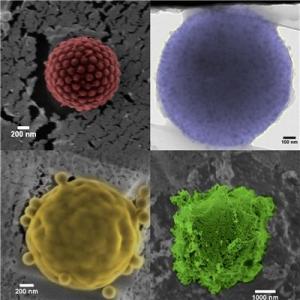Feb 1 2011
The ability of some forms of plankton and bacteria to build an extra natural layer of nanoparticle-like armour has inspired chemists at the University of Warwick to devise a startlingly simple way to give drug bearing polymer vesicles (microscopic polymer based sacs of liquid) their own armoured protection.
The Warwick researchers have been able to decorate these hollow structures with a variety of nanoparticles opening a new strategy in the design of vehicles for drug release, for example by giving the vesicle “stealth” capabilities which can avoid the body’s defences while releasing the drug.
 Four different types of armour added by tthe University of Warwick researchers
Four different types of armour added by tthe University of Warwick researchers
Advances in polymerisation have led to a surge in the creation of vesicles made from polymer molecules. Such vesicles have interesting chemical and physical properties which makes these hollow structures potential drug delivery vehicles.
The University of Warwick team were convinced that even more strength, and interesting tailored properties, could be given to the vesicles if they could add an additional layer of colloidal armour made from a variety of nanoparticles.
Lead researcher on the University of Warwick team Associate Professor Stefan Bon said:
“We took our inspiration from nature, in how it adds protection and mechanical strength in certain classes of cells and organisms. In addition to the mechanical strength provided by the cytoskeleton of the cell, plants, fungi, and certain bacteria have an additional cell wall as outermost boundary. Organisms that particularly attracted our interest were those with a cell wall composed of an armour of colloidal objects – for instance bacteria coated with S-layer proteins, or phytoplankton, such as the coccolithophorids, which have their own CaCO3-based nano-patterned colloidal armour”
The Warwick researchers hit on a surprisingly simple and highly effective method of adding a range of different types of additional armour to the polymer based vesicles. One of those armour types was a highly regular packed layer of microscopic polystyrene balls. This configuration meant the researchers could design a vesicle which had an additional and precise permeable reinforced barrier for drug release, as a result of the crystalline-like ordered structure of the polystyrene balls.
The researchers also succeeded in using the same technique to add a gelatine-like polymer to provide a “stealth” armour to shield vesicles from unwanted attention from the body’s immune system while it slowly released its drug treatment. This particular coating (a poly((ethyl acrylate)-co-(methacrylic acid)) hydrogel) absorbs so much surrounding water into its outer structure that it may be able to fool the body’s defence mechanism into believing it is in fact just water.
The Warwick researchers had the idea of simply giving their chosen colloidal particles, or latex, based armour the opposite charge to that of the polymer vesicles, to bind them together. This turned out to be even more effective and easy to manipulate and tailor than they even they had hoped for. However the researchers needed a new way of actually observing the vesicles to see if their plan had worked. Previous observational methods required researchers to dry out the vesicles before examining then under an electron microscope – but this seriously deformed the vesicles and thus provide little useful data. However the University of Warwick had recently acquired a cryo electron microscope thanks to funding from the Science City programme. This allowed the research team to quickly freeze the vesicles to -150o preserving the vesicles shape before observation by the electron microscope. This revealed that the researchers’ simple charge based method had worked exactly as planned.
Source: http://www2.warwick.ac.uk/